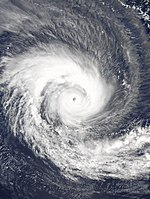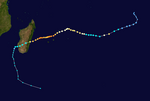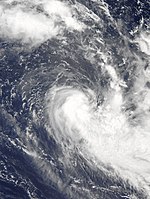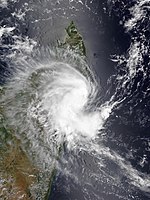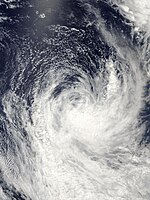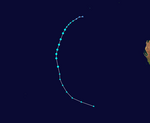2021–22 South-West Indian Ocean cyclone season
| 2021–22 South-West Indian Ocean cyclone season | |
|---|---|
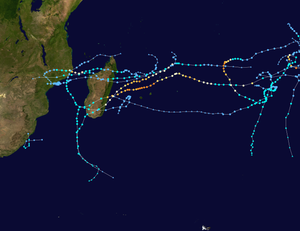 Season summary map | |
| Seasonal boundaries | |
| First system formed | 20 January 2022 (record latest) |
| Last system dissipated | Season ongoing |
| Strongest storm | |
| Name | Batsirai |
| • Maximum winds | 195 km/h (120 mph) (10-minute sustained) |
| • Lowest pressure | 934 hPa (mbar) |
| Seasonal statistics | |
| Total disturbances | 6 |
| Total depressions | 6 |
| Total storms | 6 |
| Tropical cyclones | 2 |
| Intense tropical cyclones | 1 |
| Very intense tropical cyclones | 0 |
| Total fatalities | 254 total |
| Total damage | > $53.3 million (2022 USD) |
| Related articles | |
The 2021–22 South-West Indian Ocean cyclone season is an ongoing event of the annual cycle of tropical cyclone and subtropical cyclone formation. The season began on 15 November 2021, and it will end on 30 April 2022, with the exception for Mauritius and the Seychelles, for which it will end on 15 May 2022. The season's first storm, Moderate Tropical Storm Ana, formed on 20 January 2022, marking the latest first storm in a Southwest Indian Ocean cyclone season ever.[1][2] The second, and strongest storm of the season so far, Cyclone Batsirai, formed on 24 January, and became a long-lived and powerful storm. It cruised west, and eventually made landfall in Madagascar as a Category 3-equivalent storm. These dates conventionally delimit the period of each year when most tropical and subtropical cyclones form in the basin, which is west of 90°E and south of the Equator. However, tropical cyclones that form at any time between 1 July 2021 and 30 June 2022 will count towards the season total. Tropical and subtropical cyclones in this basin are monitored by the Regional Specialised Meteorological Centre in Réunion and unofficially by the Joint Typhoon Warning Center.
Seasonal summary

Systems
Moderate Tropical Storm Ana
| Moderate tropical storm (MFR) | |
| Tropical storm (SSHWS) | |
| Duration | 20 January – 25 January |
|---|---|
| Peak intensity | 85 km/h (50 mph) (10-min); 990 hPa (mbar) |
At 07:30 UTC on 20 January, the Joint Typhoon Warning Center began monitoring an area of convection, which they designated as Invest 93S, approximately 378 nmi (700 km; 435 mi) from Mauritius, with the agency giving a low chance for potential cyclogenesis within the next 24 hours.[3] At midday, the MFR observed a closed circulation north-northwest of Saint-Brandon, with a rather ill-defined center.[4] Early the next day, at 02:00 UTC, the JTWC issued a Tropical Cyclone Formation Alert (TCFA) for Invest 93S, as the agency noted its consolidation of a well-defined low-level center.[5] Later at 12:00 UTC, the MFR declared the tropical low pressure system as a zone of disturbed weather, making it the first system of the season.[6] Twelve hours later, the MFR upgraded it to tropical disturbance status, as they found that the system's cloud pattern had improved.[7] The disturbance consolidated further and developed distinct curved rainbands, which prompted the MFR to upgrade it to a tropical depression by 06:00 UTC on 22 January.[8] Between 08:00 UTC and 09:00 UTC, the system's center crossed between Toamasina and Île Sainte-Marie as a tropical depression, with the MFR re-classifying the system as a overland depression.[9][10] Following landfall, the system weakened slightly, though its structure remained intact.[10] At 06:00 UTC the next day, the MFR re-classified it again as a tropical disturbance after entering the Mozambique Channel.[11] Six hours later, it re-intensified into a tropical depression, as it gradually improved its convective structure and cooling of its convective bands.[12] At 15:00 UTC on 23 January, the JTWC declared the system a tropical cyclone and designated it 07S.[13] The MFR later upgraded it to a moderate tropical storm and named it Ana, making it the first named storm of the season.[14] Ana maintained its intensity until at 08:00 UTC the same day, when it made landfall near south of Angoche, Mozambique.[15][16] The system later moved westwards as an overland depression, after the landfall, crossing across southern Malawi and northern Zimbabwe, and by midday of 25 January it became a remnant low over the adjoining areas of Zimbabwe and Zambia.[17] The remnant later moved towards Angola and was last noted on 30 January around Namibia and Angola.[18]
Despite a weak system, Ana caused devastating floods in Madagascar, Malawi and Mozambique killing 88 people in total.[19] Before becoming a moderate tropical storm, Ana made landfall as a tropical depression in Madagascar causing heavy rainfall which led to deadly landslides and floods. Ana caused 48 fatalities in Madagascar.[19] An estimated 55,000 people had become homeless and 130,000 were forced to flee to temporary habitation centres.[20][21] In Mozambique, at least 20 people had died and 10,000 homes had been destroyed. An additional 20,000 got affected by the cyclone.[19][21] In Malawi, 200,000 people had been displaced and 20 fatalities had been reported. Catastrophic flooding has caused severe damages to infrastructure and powerlines, which led to severe power outages mainly in the affected area.[21] The Kapichira hydroelectric dam was badly damaged due to the flash floods. Because of this, the government of Malawi declared as "state of natural disaster".[22]
Intense Tropical Cyclone Batsirai
| Intense tropical cyclone (MFR) | |
| Category 4 tropical cyclone (SSHWS) | |
| Duration | 24 January – 8 February |
|---|---|
| Peak intensity | 195 km/h (120 mph) (10-min); 934 hPa (mbar) |
On 23 January, when the JTWC declared Invest 93S as Tropical Cyclone 07S which would later Tropical Storm Ana at 15:00 UTC, the JTWC also noted an area of convection which was designated as Invest 96S over the eastern part of the basin, located approximately 493 nmi (913 km; 567 mi) from the Cocos Islands half an hour later, along with its disorganized convection over a board LLC. The agency gave a low chance for potential cyclogenesis in next 24 hours.[23] A day later at 00:30 UTC, the agency upgraded to medium after the system gradually improved its convective pattern.[24] Later at 21:30 UTC the same day, the agency issued a TCFA for Invest 96S, after noting its obscure LLC.[25] Meanwhile, at midday of 25 January, the MFR recognized the same low pressure system and later upgraded it to a tropical disturbance status at 06:00 UTC the next day.[26][27] According to them, the system's convection had shown signs of gradual organization since 24 January. The center had become better defined with low-level clouds converging towards it in a defined circular pattern, suggesting that a closed circulation had formed.[27] The MFR further upgraded it to a tropical depression at 12:00 UTC the same day, as it continued to improve its convective structure along its low-level center.[28] After its convective activity briefly interrupted after 18:00 UTC due to dry air,[29] the JTWC recognized the system as a tropical cyclone at 03:00 UTC the next day.[30] The MFR followed three hours later, by upgrading it to a moderate tropical storm and named it Batsirai.[31] Between 06:00 UTC and 12:00 UTC, Batsirai underwent a rapid deepening and intensified from a moderate tropical storm to an intense tropical cyclone within a span of just three hours. According to the MFR, it was favoured by the very small size of the system and its fast movement. It had also established an inner core of 75 to 90 km (45 to 55 mi) in diameter.[32] Two hours later, the JTWC also upgraded it to a Category 2 tropical cyclone, as it developed a small eye at about 7 nmi (13 km; 8.1 mi) in diameter.[33] However, by 18:00 UTC, it started to rapidly decline after its eye quickly collapsed and the cloud tops had warmed since. Because of these reasons, the MFR downgraded to a tropical cyclone.[34] At midnight of 28 January, it further downgraded to a moderate tropical storm, after further weakening of the convective structure.[35] Three hours later, the JTWC downgraded back to a tropical storm status.[36]
Batsirai resumed its intensification after upgrading to a severe tropical storm status at 06:00 UTC the next day.[37] Nine hours later, the JTWC upgraded to a Category 1 tropical cyclone.[38] At 03:00 UTC of 30 January, the JTWC further upgraded to a Category 2 tropical cyclone after noting a well-defined central dense overcast (CDO) and a microwave eye feature.[39] The MFR further upgraded it to a tropical cyclone status at midday.[40] Three hours later, the JTWC upgraded to a Category 3 tropical cyclone, as its eyewall had expanded and also developed a 5 nmi (9.3 km; 5.8 mi) wide pinhole-eye.[41] However it was short lived and it re-declined to a Category 1 status by 03:00 UTC of 1 February, as its pinhole-shaped eye just collapsed shortly and its eyewall became disorganized. Possibly because of its struggle to maintain its convective structure against the ever increasing vertical wind shear (VWS), despite high sea-surface temperature (SST).[42][43] But at 15:00 UTC the same day, it did a comeback to a Category 2 status, as it managed to consolidate and its eye feature re-appeared in the satellite imagery.[44] Three hours later, the MFR upgraded it to an intense tropical cyclone status.[45] By 03:00 UTC of February 2, it went for another round of rapid intensification from a Category 2 to a Category 4 tropical cyclone, according to the JTWC.[46] Its eyewall rapidly organized and also developed a 15 nmi (28 km; 17 mi) wide eye.[46] After reaching its peak at 12:00 UTC, satellite imagery depicted formation of another eyewall and also showed signs of weakening at 15:00 UTC. This indicated the beginning of the eyewall replacement cycle.[47][48]
Moderate Tropical Storm Cliff
| Moderate tropical storm (MFR) | |
| Tropical storm (SSHWS) | |
| Duration | 3 February – 5 February |
|---|---|
| Peak intensity | 75 km/h (45 mph) (10-min); 994 hPa (mbar) |
On January 31, the MFR reported a formation of a weak area of low pressure east of Cyclone Batsirai,[49] which later the JTWC recognized the same circulation as Invest 90S, at 08:00 UTC of February 2, after they noted a formation of a LLC. The agency gave a medium chance for possible cyclogenesis in next 24 hours.[50] Two days later at 03:00 UTC the JTWC upgraded to a high chance of cyclogenesis and issued a TCFA for the invest,[51] which the agency shortly upgraded to a tropical cyclone status, after noting the defined but obscured LLC.[52] At midday, the MFR followed and declared the same low as a tropical depression, as its convection had well-developed under the approaching favourable inflow from the southwest of the system's center.[53] Later in the evening, the MFR upgraded to a moderate tropical storm and was shortly named Cliff by the Mauritius Meteorological Service. Numerous satellite imagery indicated the continued development near the system's low-level center and the development a curved band pattern.[54] However by midnight of February 5, Cliff weakened as its cloud pattern had deteriorated and the banding features had almost vanished, with the LLC displaced southwards from its center. This caused under the effects of the increasing northerly wind shear.[55] By 06:00 UTC, Cliff further declined as its convection further degraded and its center displaced towards far south, mainly because of intrusion of dry air and the further strengthening of the north-westerly wind shear.[56] Six hours later, the MFR issued its last bulletin and declared as a "filling up" low, as its central pressure started to rapidly rise and its low-level center had been further exposed to the northerly wind shear.[57] On the next day at 21:00 UTC, the JTWC also issued its final update about Cliff.[58] The remnants of Cliff meandered in the open-sea and briefly passing west of the Reunion island on February 11,[59] until on February 12 it had been completed dissipated.[60]
Moderate Tropical Storm Dumako
| Moderate tropical storm (MFR) | |
| Tropical storm (SSHWS) | |
| Duration | 10 February – 18 February |
|---|---|
| Peak intensity | 85 km/h (50 mph) (10-min); 993 hPa (mbar) |
On February 11, a tropical disturbance formed in the central South Indian Ocean, and was then designated as 04. The next day, February 12, the system intensified into a tropical depression. At 06:00 UTC on February 13, Tropical Depression 04 intensified into a moderate tropical storm, and was therefore given the name, Dumako. Dumako slowly intensified for the rest of February 13 and up until 06:00 UTC February 14 where MFR estimated peak intensity of 50 mph (85 km/h) with pressure of 993 hPa, and the JTWC estimated slightly higher windspeed of 60 mph (95 km/h). For the rest of February 14 and up until right before landfall at 09:00 UTC on February 15, Dumako slowly weakened and experienced higher wind shear simultaneous. It weakened overnight rapidly due to rugged terrain and the JTWC gave last warning on the system on 21:00 UTC of February 15. 14 people died in the storm.[61][62]
Intense Tropical Cyclone Emnati
| |||
|---|---|---|---|
Current storm status Category 3 tropical cyclone (1-min mean) | |||
| |||
| As of: | 09:00 UTC, 20 February | ||
| Location: | 17°24′S 55°36′E / 17.4°S 55.6°E ± 20 nmi About 191 nmi (354 km; 220 mi) NNW of Port Louis, Mauritius | ||
| Sustained winds: | 85 knots (155 km/h; 100 mph) (10-min mean) gusting to not specified 105 knots (195 km/h; 120 mph) (1-min mean) | ||
| Pressure: | 955 hPa (28.20 inHg) | ||
| Movement: | WSW at 7 knots (13 km/h; 8.1 mph) | ||
| See more detailed information. | |||
Emnati initially developed as a zone of disturbed weather where it moved westwards over the open waters in Indian Ocean Environmental conditions were assessed as being marginally conducive for tropical cyclogenesis, with warm sea surface temperatures near 28 °C (82 °F) and low vertical wind the disturbance located about 420 nautical miles (780 km; 480 mi) to Diego Garcia south [63][64] On the same day, the JTWC issued a Tropical Cyclone Formation Alert on the system and by 21:00 UTC JTWC subsequently initiated advisories on the system and classified it Tropical Cyclone 13S.[65] The next day, the system organized into a tropical disturbance.[66] The system continued organizing, and at 12:00 UTC, MFR upgraded the system to a tropical depression.[67] By the 17 February, the MFR reported that the system had become a moderate tropical storm and the Sub-Regional Tropical Cyclone Advisory Center in Mauritius named it Emnati.[68][69]
Current storm information
As of 09:00 UTC 20 February, Tropical Cyclone Emnati is located within 20 nautical miles of 17°24′S 55°36′E / 17.4°S 55.6°E, approximately 191 nmi (354 km; 220 mi) north-northwest of Port Louis, Mauritius. Maximum 10-minute sustained winds are at 85 knots (155 km/h; 100 mph), with gusts up not specified, while maximum 1-minute sustained winds are at 105 knots (195 km/h; 120 mph). The minimum central barometric pressure is 955 hPa (28.20 inHg) and the system moving west-southwest at 7 knots (13 km/h; 8.1 mph).
For the latest official information see:
- MFR's Cyclonic Analysis and Forecast Bulletins on Tropical Cyclone Emnati (05)
- JTWC's Tropical Cyclone Warning on Tropical Cyclone 13S (Emnati)
Moderate Tropical Storm Fezile
| Moderate tropical storm (MFR) | |
| Subtropical storm (SSHWS) | |
| Duration | 16 February (Entered basin) – 18 February |
|---|---|
| Peak intensity | 85 km/h (50 mph) (10-min); 980 hPa (mbar) |
On 16 February, Tropical Low 19U moved into the basin from the Australian region, and was reclassified as Zone of Disturbed Weather 06. Then the JTWC issued a TCFA on the system stating that it could intensify but was eventually cancelled by the next day due to encountering with low sea surface temperatures. Contrary to it, the MFR named the system as Fezile as it peaked as a moderate tropical storm. On 18 February, the MFR stopped tracking the system as it reached farther latitudes and became extratropical.
Storm names
Within the South-West Indian Ocean, tropical depressions and subtropical depressions that are judged to have 10-minute sustained windspeeds of 65 km/h (40 mph) by the Regional Specialized Meteorological Center on Réunion island, France (RSMC La Réunion) are usually assigned a name. However, it is the Sub-Regional Tropical Cyclone Advisory Centers in Mauritius and Madagascar who name the systems. The Sub-Regional Tropical Cyclone Advisory Center (Mauritius Meteorological Services) in Mauritius names a storm should it intensify into a moderate tropical storm between 55°E and 90°E. If instead a cyclone intensifies into a moderate tropical storm between 30°E and 55°E then the Sub-Regional Tropical Cyclone Advisory Center (Madagascar Meteorological Services) in Madagascar assigns the appropriate name to the storm. Storm names are taken from three pre-determined lists of names, which rotate on a triennial basis, with any names that have been used automatically removed. Therefore, all storm names used this year will be removed from the rotation and replaced with a new name for the 2024–25 season, while the unused names will remain on the list.[70] New names this season are: Ana, Batsirai, Cliff, Dumako, Emnati, Fezile, Gombe, Halima, Issa, Jasmine, Karim, and Letlama. They replaced Alcide, Bouchra, Cilida, Desmond, Eketsang, Funani, Gelena, Haleh, Idai, Joaninha, Kenneth, and Lorna after the 2018–19 season.
|
|
Season effects
This table lists all of the tropical cyclones and subtropical cyclones that were monitored during the 2021–2022 South-West Indian Ocean cyclone season. Information on their intensity, duration, name, areas affected, primarily comes from RSMC La Réunion. Death and damage reports come from either press reports or the relevant national disaster management agency while the damage totals are given in 2021 or 2022 USD.
| Name | Dates | Peak intensity | Areas affected | Damage (USD) |
Deaths | Refs | ||
|---|---|---|---|---|---|---|---|---|
| Category | Wind speed | Pressure | ||||||
| Ana | 20 – 25 January | Moderate tropical storm | 85 km/h (50 mph) | 990 hPa (29.23 inHg) | Mauritius, Madagascar, Mozambique, South Africa, Malawi, Zimbabwe, Zambia | Unknown | 115 | [19] |
| Batsirai | 24 January – 8 February | Intense tropical cyclone | 195 km/h (120 mph) | 934 hPa (27.58 inHg) | Mauritius, Réunion, Madagascar | > $53.3 million | 123 | [71][72] |
| Cliff | 3 – 5 February | Moderate tropical storm | 75 km/h (45 mph) | 994 hPa (29.35 inHg) | None | None | None | |
| Dumako | 10 – 18 February | Moderate tropical storm | 85 km/h (50 mph) | 993 hPa (29.32 inHg) | Madagascar, Mozambique | Unknown | 6 | [73] |
| Emnati | 15 February – Present | Tropical cyclone | 155 km/h (100 mph) | 955 hPa (28.20 inHg) | Mauritius | None | None | |
| Fezile | 16 – 18 February | Moderate tropical storm | 75 km/h (45 mph) | 980 hPa (28.94 inHg) | None | None | None | |
| Season aggregates | ||||||||
| 6 systems | 20 January – Season ongoing | 195 km/h (120 mph) | 934 hPa (27.58 inHg) | > $53.3 million | 254 | |||
See also
- Weather of 2021 and 2022
- List of Southern Hemisphere cyclone seasons
- Tropical cyclones in 2021 and 2022
- Atlantic hurricane seasons: 2021, 2022
- Pacific hurricane seasons: 2021, 2022
- Pacific typhoon seasons: 2021, 2022
- North Indian Ocean cyclone seasons: 2021, 2022
- 2021–22 Australian region cyclone season
- 2021–22 South Pacific cyclone season
References
- ^ "Cronaca meteo. Africa, la tempesta tropicale Ana fa landfall in Mozambico". 3BMeteo | Previsioni Meteo (in Italian). 24 January 2022. Archived from the original on 26 January 2022. Retrieved 26 January 2022.
- ^ The Meteorological Office [@metofficestorms] (23 January 2022). "Tropical Storm #Ana has formed and will soon be making landfall over #Mozambique. The 2021-22 season in the Southwest Indian Ocean is making an unusually late start - Ana is the latest that the first named storm of the season has formed since 1998" (Tweet). Exeter, Devon, UK. – via Twitter.
- ^ Significant Tropical Weather Advisory for the Indian Ocean Reissued (Report). United States Joint Typhoon Warning Center. 20 January 2022. Archived from the original on 20 January 2022. Retrieved 23 January 2022.
- ^ "Bulletin for Cyclonic Activity and Significant Tropical Weather in the Southwestern Indian Ocean" (PDF). La Réunion, France: Météo-France. 20 January 2022. Archived (PDF) from the original on 24 January 2022. Retrieved 23 January 2022.
- ^ Tropical Cyclone Formation Alert (Invest 93S) (Report). United States Joint Typhoon Warning Center. 21 January 2022. Archived from the original on 20 January 2022. Retrieved 23 January 2022.
- ^ "Zone of Disturbed Weather 1 Warning Number 1/1/20212022" (PDF). La Réunion, France: Météo-France. 21 January 2022. Archived (PDF) from the original on 24 January 2022. Retrieved 23 January 2022.
- ^ "Tropical Disturbance 1 Warning Number 2/1/20212022" (PDF). La Réunion, France: Météo-France. 22 January 2022. Archived (PDF) from the original on 22 January 2022. Retrieved 23 January 2022.
- ^ "Tropical Depression 1 Warning Number 3/1/20212022" (PDF). La Réunion, France: Météo-France. 22 January 2022. Archived (PDF) from the original on 22 January 2022. Retrieved 24 January 2022.
- ^ "Overland Depression 1 Warning Number 4/1/20212022" (PDF). La Réunion, France: Météo-France. 22 January 2022. Archived (PDF) from the original on 24 January 2022. Retrieved 24 January 2022.
- ^ a b "Overland Depression 1 Warning Number 5/1/20212022" (PDF). La Réunion, France: Météo-France. 22 January 2022. Archived (PDF) from the original on 23 January 2022. Retrieved 24 January 2022.
- ^ "Tropical Disturbance 1 Warning Number 7/1/20212022" (PDF). La Réunion, France: Météo-France. 23 January 2022. Archived (PDF) from the original on 23 January 2022. Retrieved 24 January 2022.
- ^ "Tropical Disturbance 1 Warning Number 8/1/20212022" (PDF). La Réunion, France: Météo-France. 23 January 2022. Archived (PDF) from the original on 23 January 2022. Retrieved 24 January 2022.
- ^ Prognostic Reasoning for Tropical Cyclone 07S (Seven) Warning No. 1 (Report). United States Joint Typhoon Warning Center. 23 January 2022. Archived from the original on 23 January 2022. Retrieved 24 January 2022.
- ^ "Moderate Tropical Storm 1 (Ana) Warning Number 10/1/20212022" (PDF). La Réunion, France: Météo-France. 24 January 2022. Archived (PDF) from the original on 24 January 2022. Retrieved 24 January 2022.
- ^ "Moderate Tropical Storm 1 (Ana) Warning Number 12/1/20212022" (PDF). La Réunion, France: Météo-France. 24 January 2022. Archived (PDF) from the original on 3 February 2022. Retrieved 1 February 2022.
- ^ "Bulletin for Cyclonic Activity and Significant Tropical Weather in the Southwestern Indian Ocean" (PDF). La Réunion, France: Météo-France. 24 January 2022. Archived (PDF) from the original on 1 February 2022. Retrieved 1 February 2022.
- ^ "Overland Depression 1 (Ana) Warning Number 16/1/20212022" (PDF). La Réunion, France: Météo-France. 25 January 2022. Archived (PDF) from the original on 1 February 2022. Retrieved 2 February 2022.
- ^ "Bulletin for Cyclonic Activity and Significant Tropical Weather in the Southwestern Indian Ocean" (PDF). La Réunion, France: Météo-France. 30 January 2022. Archived (PDF) from the original on 1 February 2022. Retrieved 2 February 2022.
- ^ a b c d "Storm Ana deaths rise to 88 as second storm brews to Africa's east". www.reuters.com. Johannesburg, South Africa: Reuters. 28 January 2022. Archived from the original on 1 February 2022. Retrieved 2 February 2022.
- ^ Gregory Gondwe (25 January 2022). "Malawi hit by flooding caused by tropical storm Ana; 1 dead". apnews.com. Blantyre, Malawi: The Associated Press. Archived from the original on 1 February 2022. Retrieved 2 February 2022.
- ^ a b c "Storm Ana kills dozens in Malawi, Madagascar and Mozambique". www.bbc.com. British Broadcasting Channel (BBC). 28 January 2022. Archived from the original on 3 February 2022. Retrieved 2 February 2022.
- ^ "Storm Ana kills at least three in Mozambique and Malawi". www.reuters.com. Maputo, Mozambique: Reuters. 26 January 2022. Archived from the original on 2 February 2022. Retrieved 2 February 2022.
- ^ Significant Tropical Weather Advisory for the Indian Ocean Reissued (Report). United States Joint Typhoon Warning Center. 23 January 2022. Archived from the original on 23 January 2022. Retrieved 29 January 2022.
- ^ Significant Tropical Weather Advisory for the Indian Ocean Reissued (Report). United States Joint Typhoon Warning Center. 24 January 2022. Archived from the original on 24 January 2022. Retrieved 29 January 2022.
- ^ Tropical Cyclone Formation Alert (Invest 96S) (Report). United States Joint Typhoon Warning Center. 24 January 2022. Archived from the original on 24 January 2022. Retrieved 29 January 2022.
- ^ "Bulletin for Cyclonic Activity and Significant Tropical Weather in the Southwestern Indian Ocean" (PDF). La Réunion, France: Météo-France. 25 January 2022. Retrieved 29 January 2022.
{{cite web}}: CS1 maint: url-status (link) - ^ a b "Tropical Disturbance 2 Warning Number 1/2/20212022" (PDF). La Réunion, France: Météo-France. 26 January 2022. Retrieved 29 January 2022.
{{cite web}}: CS1 maint: url-status (link) - ^ "Tropical Depression 2 Warning Number 2/2/20212022" (PDF). La Réunion, France: Météo-France. 26 January 2022. Retrieved 29 January 2022.
{{cite web}}: CS1 maint: url-status (link) - ^ "Tropical Depression 2 Warning Number 3/2/20212022" (PDF). La Réunion, France: Météo-France. 26 January 2022. Retrieved 29 January 2022.
{{cite web}}: CS1 maint: url-status (link) - ^ Prognostic Reasoning for Tropical Cyclone 08S (Eight) Warning No. 1 (Report). United States Joint Typhoon Warning Center. 27 January 2022. Archived from the original on 27 January 2022. Retrieved 29 January 2022.
- ^ "Moderate Tropical Storm 2 (Batsirai) Warning Number 5/2/20212022" (PDF). La Réunion, France: Météo-France. 27 January 2022. Retrieved 29 January 2022.
{{cite web}}: CS1 maint: url-status (link) - ^ "*CORRECTED* Intense Tropical Cyclone 2 (Batsirai) Warning Number 6/2/20212022" (PDF). La Réunion, France: Météo-France. 27 January 2022. Retrieved 29 January 2022.
{{cite web}}: CS1 maint: url-status (link) - ^ Prognostic Reasoning for Tropical Cyclone 08S (Batsirai) Warning No. 2 (Report). United States Joint Typhoon Warning Center. 27 January 2022. Archived from the original on 27 January 2022. Retrieved 29 January 2022.
- ^ "Tropical Cyclone 2 (Batsirai) Warning Number 7/2/20212022" (PDF). La Réunion, France: Météo-France. 27 January 2022. Retrieved 29 January 2022.
{{cite web}}: CS1 maint: url-status (link) - ^ "Moderate Tropical Storm 2 (Batsirai) Warning Number 8/2/20212022" (PDF). La Réunion, France: Météo-France. 28 January 2022. Retrieved 29 January 2022.
{{cite web}}: CS1 maint: url-status (link) - ^ Prognostic Reasoning for Tropical Cyclone 08S (Batsirai) Warning No. 3 (Report). United States Joint Typhoon Warning Center. 28 January 2022. Archived from the original on 28 January 2022. Retrieved 29 January 2022.
- ^ "Severe Tropical Storm 2 (Batsirai) Warning Number 13/2/20212022" (PDF). La Réunion, France: Météo-France. 29 January 2022. Retrieved 31 January 2022.
{{cite web}}: CS1 maint: url-status (link) - ^ Prognostic Reasoning for Tropical Cyclone 08S (Batsirai) Warning No. 6 (Report). United States Joint Typhoon Warning Center. 29 January 2022. Archived from the original on 31 January 2022. Retrieved 31 January 2022.
- ^ Prognostic Reasoning for Tropical Cyclone 08S (Batsirai) Warning No. 7 (Report). United States Joint Typhoon Warning Center. 30 January 2022. Archived from the original on 31 January 2022. Retrieved 31 January 2022.
- ^ "Tropical Cyclone 2 (Batsirai) Warning Number 18/2/20212022" (PDF). La Réunion, France: Météo-France. 30 January 2022. Retrieved 31 January 2022.
{{cite web}}: CS1 maint: url-status (link) - ^ Prognostic Reasoning for Tropical Cyclone 08S (Batsirai) Warning No. 8 (Report). United States Joint Typhoon Warning Center. 30 January 2022. Archived from the original on 31 January 2022. Retrieved 31 January 2022.
- ^ Prognostic Reasoning for Tropical Cyclone 08S (Batsirai) Warning No. 10 (Report). United States Joint Typhoon Warning Center. 31 January 2022. Archived from the original on 31 January 2022. Retrieved 3 February 2022.
- ^ Prognostic Reasoning for Tropical Cyclone 08S (Batsirai) Warning No. 11 (Report). United States Joint Typhoon Warning Center. 31 January 2022. Archived from the original on 31 January 2022. Retrieved 3 February 2022.
- ^ Prognostic Reasoning for Tropical Cyclone 08S (Batsirai) Warning No. 12 (Report). United States Joint Typhoon Warning Center. 1 February 2022. Archived from the original on 1 February 2022. Retrieved 3 February 2022.
- ^ "Intense Tropical Cyclone 2 (Batsirai) Warning Number 27/2/20212022" (PDF). La Réunion, France: Météo-France. 1 February 2022. Retrieved 3 February 2022.
{{cite web}}: CS1 maint: url-status (link) - ^ a b Prognostic Reasoning for Tropical Cyclone 08S (Batsirai) Warning No. 13 (Report). United States Joint Typhoon Warning Center. 1 February 2022. Archived from the original on 1 February 2022. Retrieved 3 February 2022.
- ^ Prognostic Reasoning for Tropical Cyclone 08S (Batsirai) Warning No. 14 (Report). United States Joint Typhoon Warning Center. 2 February 2022. Archived from the original on 2 February 2022. Retrieved 3 February 2022.
- ^ "Intense Tropical Cyclone 2 (Batsirai) Warning Number 27/2/20212022" (PDF). La Réunion, France: Météo-France. 2 February 2022. Retrieved 3 February 2022.
{{cite web}}: CS1 maint: url-status (link) - ^ "Bulletin for Cyclonic Activity and Significant Tropical Weather in the Southwestern Indian Ocean" (PDF). La Réunion, France: Météo-France. 31 January 2022. Retrieved 18 February 2022.
{{cite web}}: CS1 maint: url-status (link) - ^ Significant Tropical Weather Advisory for the Indian Ocean Reissued (Report). United States Joint Typhoon Warning Center. 2 February 2021. Archived from the original on 2 February 2022. Retrieved 18 February 2022.
- ^ Tropical Cyclone Formation Alert (Invest 90S) (Report). United States Joint Typhoon Warning Center. 4 February 2021. Archived from the original on 4 February 2022. Retrieved 18 February 2022.
- ^ Prognostic Reasoning for Tropical Cyclone 10S (Ten) Warning No. 1 (Report). United States Joint Typhoon Warning Center. 4 February 2021. Archived from the original on 4 February 2022. Retrieved 18 February 2022.
- ^ "Tropical Depression 3 Warning Number 1/3/202122" (PDF). La Réunion, France: Météo-France. 4 February 2022. Retrieved 18 February 2022.
{{cite web}}: CS1 maint: url-status (link) - ^ "Moderate Tropical Storm 3 (Cliff) Warning Number 2/3/202122" (PDF). La Réunion, France: Météo-France. 4 February 2022. Retrieved 18 February 2022.
{{cite web}}: CS1 maint: url-status (link) - ^ "Moderate Tropical Storm 3 (Cliff) Warning Number 3/3/202122" (PDF). La Réunion, France: Météo-France. 5 February 2022. Retrieved 18 February 2022.
{{cite web}}: CS1 maint: url-status (link) - ^ "Moderate Tropical Storm 3 (Cliff) Warning Number 4/3/202122" (PDF). La Réunion, France: Météo-France. 5 February 2022. Retrieved 18 February 2022.
{{cite web}}: CS1 maint: url-status (link) - ^ "Filling Up 3 (Cliff) Warning Number 5/3/202122" (PDF). La Réunion, France: Météo-France. 5 February 2022. Retrieved 18 February 2022.
{{cite web}}: CS1 maint: url-status (link) - ^ Tropical Cyclone 10S (Cliff) Warning No. 6-FINAL (Report). United States Joint Typhoon Warning Center. 6 February 2021. Archived from the original on 4 February 2022. Retrieved 18 February 2022.
- ^ "Bulletin for Cyclonic Activity and Significant Tropical Weather in the Southwestern Indian Ocean" (PDF). La Réunion, France: Météo-France. 11 February 2022. Retrieved 18 February 2022.
{{cite web}}: CS1 maint: url-status (link) - ^ "Bulletin for Cyclonic Activity and Significant Tropical Weather in the Southwestern Indian Ocean" (PDF). La Réunion, France: Météo-France. 12 February 2022. Retrieved 18 February 2022.
{{cite web}}: CS1 maint: url-status (link) - ^ https://www.reuters.com/world/africa/madagascar-braces-next-cyclone-least-14-killed-by-storm-2022-02-19/
- ^ "Madagascar, Mozambique - Tropical Storm DUMAKO, update ( GDACS, Meteo Madagascar, BNGRC) (ECHO Daily Flash of 16 February 2022) - Madagascar". ReliefWeb. Retrieved 16 February 2022.
- ^ Significant Tropical Weather Advisory for the Indian Ocean (Report). United States Joint Typhoon Warning Center. 15 February 2022. Archived from the original on 15 February 2022. Retrieved 15 February 2022.
- ^ "Bulletin for Cyclonic Activity and Significant Tropical Weather In the Southwest Indian Ocean 2022/02/15 AT 1200 UTC" (PDF). La Réunion, France: Météo-France. 15 February 2022. Retrieved 15 February 2022.
{{cite web}}: CS1 maint: url-status (link) - ^ Tropical Cyclone Formation Alert (Invest 96S) (Report). United States Joint Typhoon Warning Center. 15 February 2022. Archived from the original on 15 February 2022. Retrieved 15 February 2022.
- ^ "Tropical Disturbance 5 Warning Number 4/5/20212022" (PDF). La Réunion, France: Météo-France. 16 February 2022. Retrieved 16 February 2022.
{{cite web}}: CS1 maint: url-status (link) - ^ "Tropical Depression 5 Warning Number 6/5/20212022" (PDF). La Réunion, France: Météo-France. 16 February 2022. Retrieved 16 February 2022.
{{cite web}}: CS1 maint: url-status (link) - ^ "Current Storm/Cyclone Moderate Tropical Storm Emnati 17 February 2022". Mauritius Meteorological Services. 17 February 2022. Archived from the original on 17 February 2022. Retrieved 17 February 2022.
- ^ "Moderate Tropical Storm Emnati 5 Warning Number 8/5/20212022" (PDF). La Réunion, France: Météo-France. 17 February 2022. Retrieved 17 February 2022.
{{cite web}}: CS1 maint: url-status (link) - ^ Regional Association I Tropical Cyclone Committee (2016). "Tropical Cyclone Operational Plan for the South-West Indian Ocean" (PDF). World Meteorological Organization. Archived (PDF) from the original on 18 September 2016. Retrieved 5 October 2016.
- ^ ion (3 February 2022). "Batsirai fait deux victimes" [Batsirai kills two]. ionnews.mu (in French). Archived from the original on 3 February 2022. Retrieved 3 February 2022.
- ^ "Madagascar's death toll from Cyclone Batsirai rises to 92". KXAN Austin. 9 February 2022. Archived from the original on 9 February 2022. Retrieved 9 February 2022.
- ^ "Madagascar – Storm Dumako Leaves 6 Dead, Homes Damaged". Flood List. 18 February 2022. Retrieved 9 February 2022.
{{cite web}}:|archive-date=requires|archive-url=(help)CS1 maint: url-status (link)



